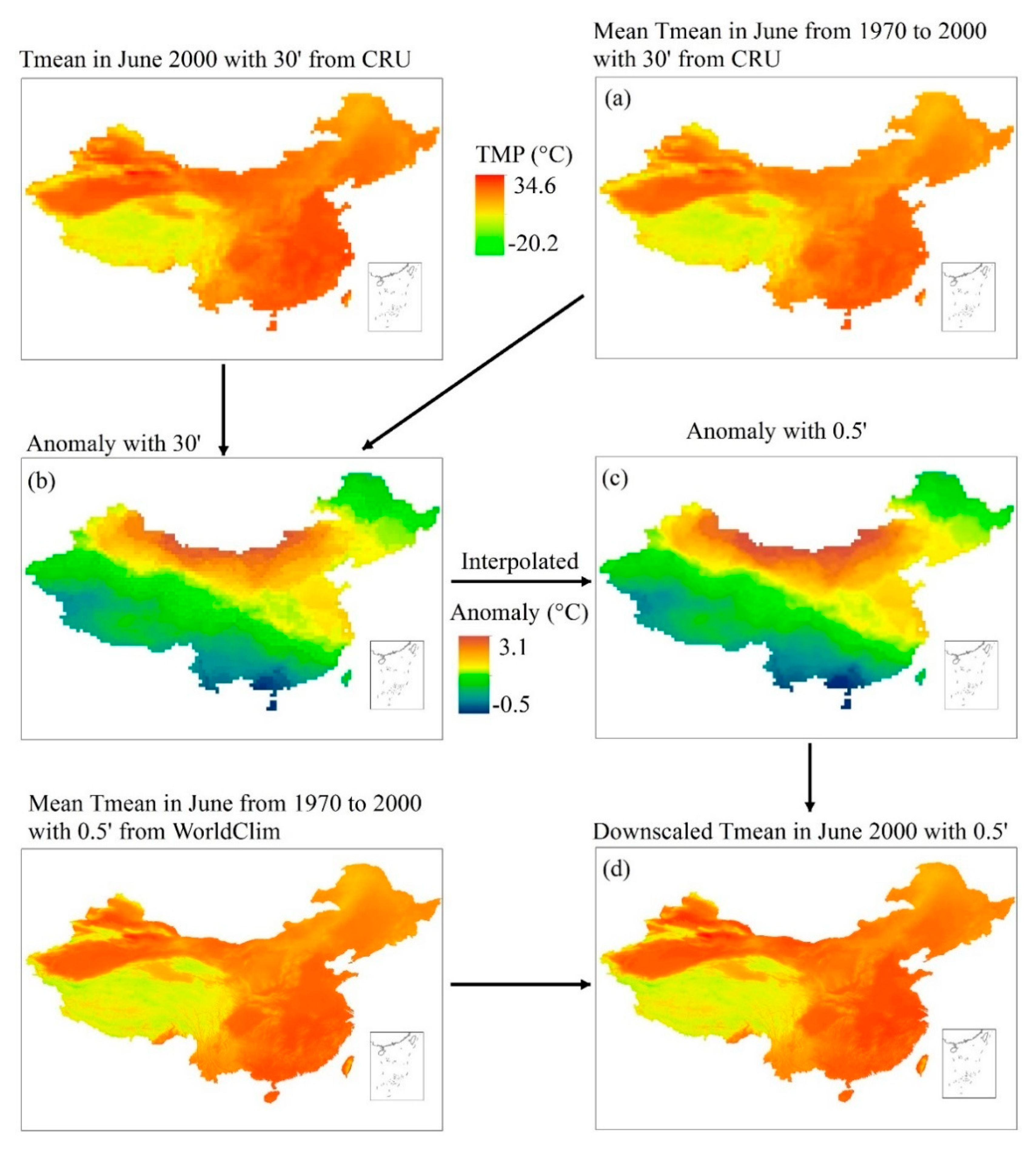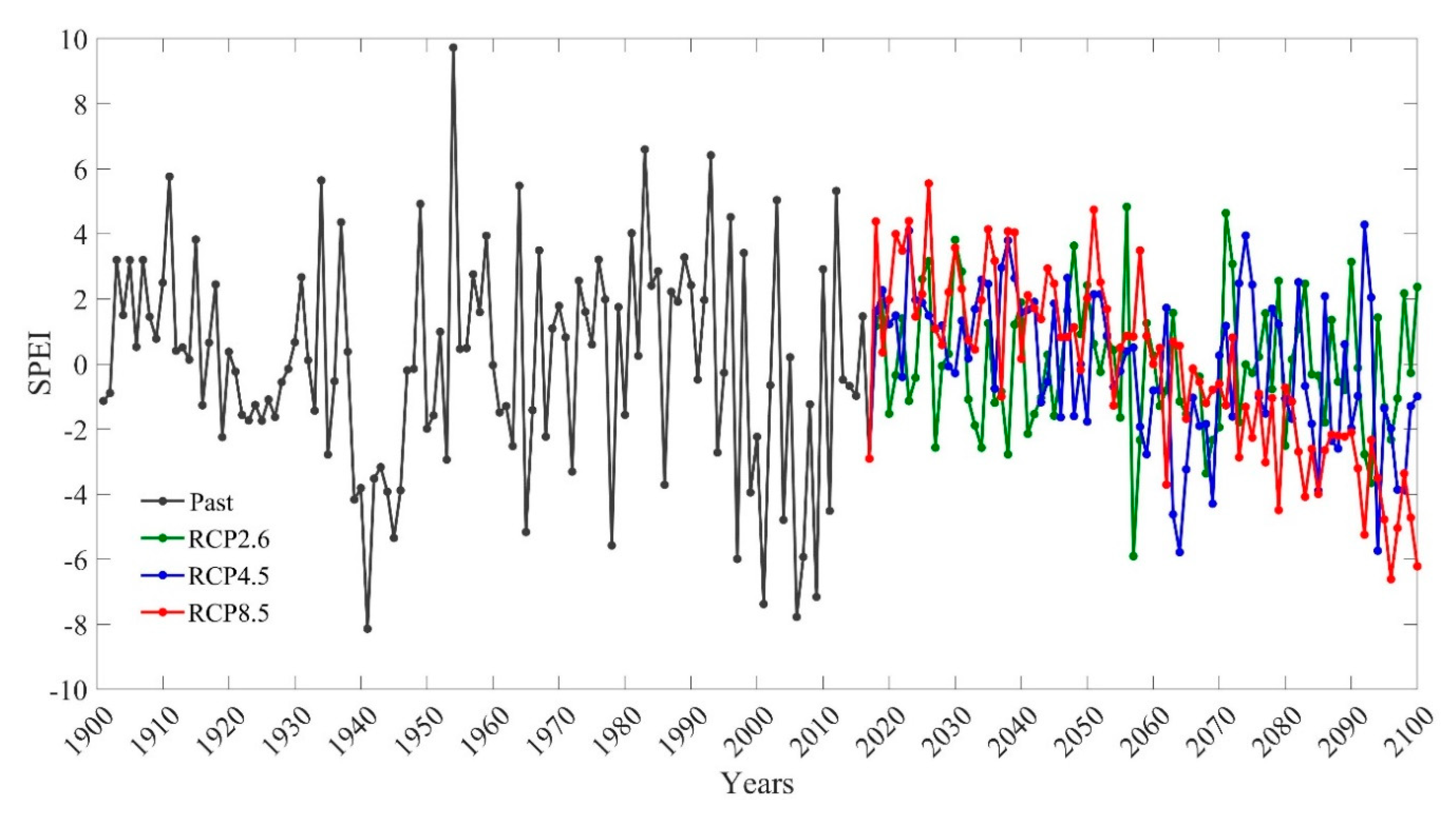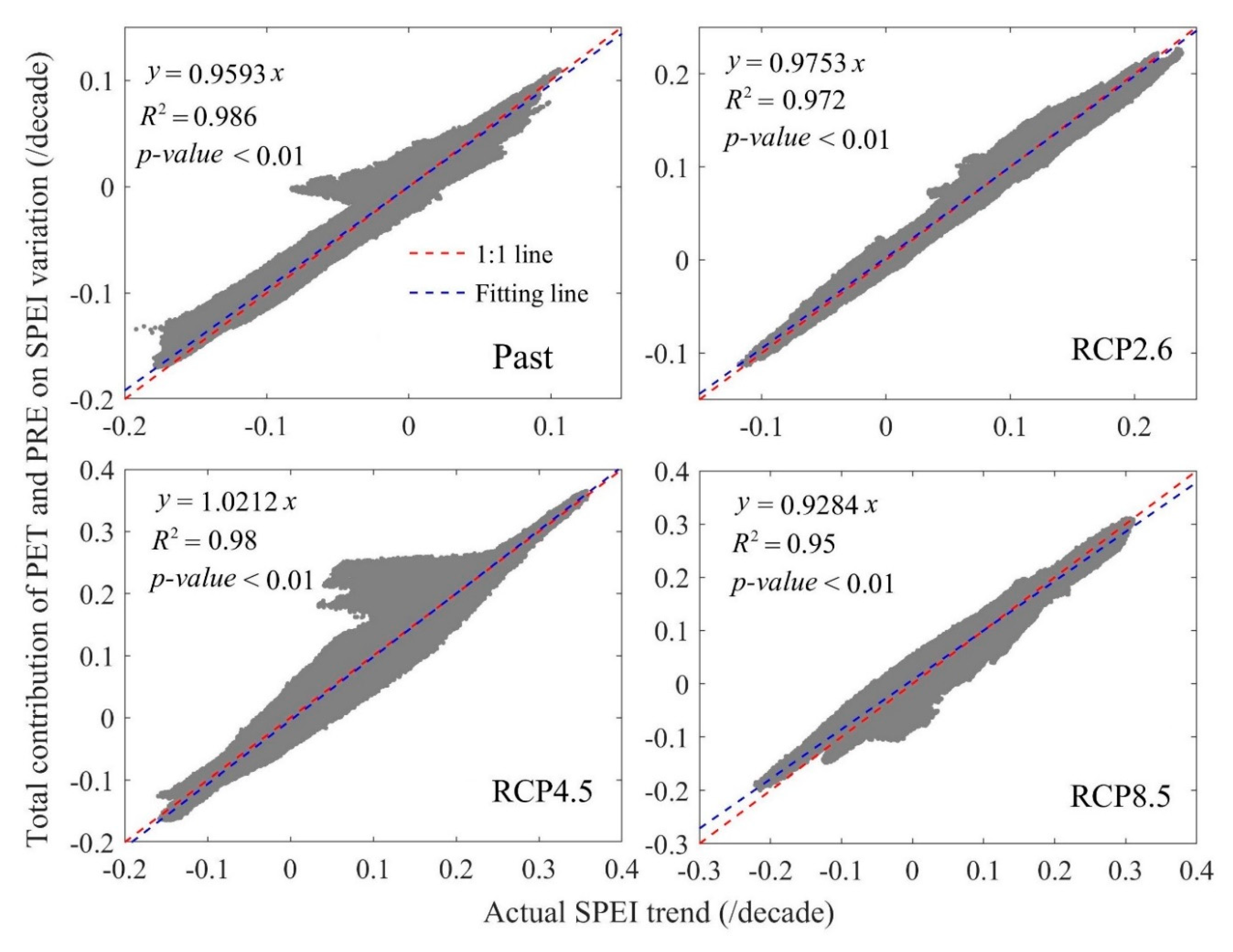Spatiotemporal Trends and Attribution of Drought across China from 1901–2100
Abstract
1. Introduction
2. Data and Methods
2.1. Data Collection
2.2. Spatial Downscaling Method
2.3. SPEI Calculation
2.4. Trend Analysis
2.5. Attribution of SPEI Variation
3. Results
3.1. Evaluation of Downscaled Temperatures and Precipitation
3.2. Spatiotemporal Trends of SPEI
3.3. Attribution of SPEI Variation
4. Summary and Discussion
Supplementary Materials
Author Contributions
Funding
Conflicts of Interest
References
- Cook, B.I.; Smerdon, J.E.; Seager, R.; Coats, S. Global warming and 21st century drying. Clim. Dyn. 2014, 43, 2607–2627. [Google Scholar] [CrossRef]
- Chou, C.; Chiang, J.C.H.; Lan, C.-W.; Chung, C.-H.; Liao, Y.-C.; Lee, C.-J. Increase in the range between wet and dry season precipitation. Nat. Geosci. 2013, 6, 263. [Google Scholar] [CrossRef]
- Cook, B.I.; Ault, T.R.; Smerdon, J.E. Unprecedented 21st century drought risk in the American Southwest and Central Plains. Sci. Adv. 2015, 1, e1400082. [Google Scholar] [CrossRef] [PubMed]
- Dai, A. Increasing drought under global warming in observations and models. Nat. Clim. Chang. 2012, 3, 52. [Google Scholar] [CrossRef]
- Piao, S.; Ciais, P.; Huang, Y.; Shen, Z.; Peng, S.; Li, J.; Zhou, L.; Liu, H.; Ma, Y.; Ding, Y.; et al. The impacts of climate change on water resources and agriculture in China. Nature 2010, 467, 43. [Google Scholar] [CrossRef]
- McKee, T.B.; Doesken, N.J.; Kleist, J. The relationship of drought frequency and duration to time scales. In Proceedings of the Eighth Conference on Applied Climatology, Anaheim, CA, USA, 17–22 January 1993; pp. 179–184. [Google Scholar]
- Palmer, W.C. Meteorological drought. Res. Pap. 1965, 45, 1–58. [Google Scholar]
- Vicente-Serrano, S.M.; Beguería, S.; López-Moreno, J.I. A multiscalar drought index sensitive to global warming: The Standardized Precipitation Evapotranspiration Index. J. Clim. 2010, 23, 1696–1718. [Google Scholar] [CrossRef]
- Vicente-Serrano, S.M.; Gouveia, C.; Camarero, J.J.; Beguería, S.; Trigo, R.; López-Moreno, J.I.; Azorín-Molina, C.; Pasho, E.; Lorenzo-Lacruz, J.; Revuelto, J.; et al. Response of vegetation to drought time-scales across global land biomes. Proc. Natl. Acad. Sci. USA 2013, 110, 52–57. [Google Scholar] [CrossRef]
- Vicente-Serrano, S.M.; Camarero, J.J.; Azorin-Molina, C. Diverse responses of forest growth to drought time–scales in the Northern Hemisphere. Glob. Ecol. Biogeogr. 2014, 23, 1019–1030. [Google Scholar] [CrossRef]
- Sun, S.; Chen, H.; Li, J.; Wei, J.; Wang, G.; Sun, G.; Hua, W.; Zhou, S.; Deng, P. Dependence of 3-month Standardized Precipitation-Evapotranspiration Index dryness/wetness sensitivity on climatological precipitation over southwest China. Int. J. Clim. 2018, 38, 4568–4578. [Google Scholar] [CrossRef]
- Li, X.; You, Q.L.; Ren, G.Y.; Wang, S.Y.; Zhang, Y.Q.; Yang, J.L.; Zheng, G.F. Concurrent droughts and hot extremes in northwest China from 1961 to 2017. Int. J. Clim. 2019, 39, 2186–2196. [Google Scholar] [CrossRef]
- Liu, Z.P.; Wang, Y.Q.; Shao, M.G.; Jia, X.X.; Li, X.L. Spatiotemporal analysis of multiscalar drought characteristics across the Loess Plateau of China. J. Hydrol. 2016, 534, 281–299. [Google Scholar] [CrossRef]
- Zhang, R.; Chen, Z.Y.; Xu, L.J.; Ou, C.Q. Meteorological drought forecasting based on a statistical model with machine learning techniques in Shaanxi province, China. Sci. Total. Environ. 2019, 665, 338–346. [Google Scholar] [CrossRef] [PubMed]
- Gao, X.R.; Zhao, Q.; Zhao, X.N.; Wu, P.T.; Pan, W.X.; Gao, X.D.; Sun, M. Temporal and spatial evolution of the standardized precipitation evapotranspiration index (SPEI) in the Loess Plateau under climate change from 2001 to 2050. Sci. Total. Environ. 2017, 595, 191–200. [Google Scholar] [CrossRef]
- Gu, L.; Chen, J.; Xu, C.-Y.; Kim, J.-S.; Chen, H.; Xia, J.; Zhang, L. The contribution of internal climate variability to climate change impacts on droughts. Sci. Total. Environ. 2019, 684, 229–246. [Google Scholar] [CrossRef]
- Kimosop, P. Characterization of drought in the Kerio Valley Basin, Kenya using the Standardized Precipitation Evapotranspiration Index: 1960–2016. Singap. J. Trop. Geogr. 2019, 40, 239–256. [Google Scholar] [CrossRef]
- Naumann, G.; Alfieri, L.; Wyser, K.; Mentaschi, L.; Betts, R.A.; Carrao, H.; Spinoni, J.; Vogt, J.; Feyen, L. Global changes in drought conditions under different levels of warming. Geophys. Res. Lett. 2018, 45, 3285–3296. [Google Scholar] [CrossRef]
- Shiru, M.S.; Shahid, S.; Chung, E.S.; Alias, N. Changing characteristics of meteorological droughts in Nigeria during 1901–2010. Atmos. Res. 2019, 223, 60–73. [Google Scholar] [CrossRef]
- Wang, Y.F.; Liu, G.X.; Guo, E.L. Spatial distribution and temporal variation of drought in Inner Mongolia during 1901–2014 using Standardized Precipitation Evapotranspiration Index. Sci. Total. Environ. 2019, 654, 850–862. [Google Scholar] [CrossRef]
- Gao, L.; Wei, J.; Wang, L.; Bernhardt, M.; Schulz, K.; Chen, X. A high-resolution air temperature data set for the Chinese Tian Shan in 1979–2016. Earth Syst. Sci. Data 2018, 10, 2097–2114. [Google Scholar] [CrossRef]
- Harris, I.; Jones, P.; Osborn, T.; Lister, D. Updated high–resolution grids of monthly climatic observations–the CRU TS3.10 Dataset. Int. J. Clim. 2014, 34, 623–642. [Google Scholar] [CrossRef]
- Giorgi, F.; Jones, C.; Asrar, G.R. Addressing climate information needs at the regional level: The CORDEX framework. World Meteorol. Org. Bull. 2009, 58, 175–183. [Google Scholar]
- Peng, S.; Gang, C.; Cao, Y.; Chen, Y. Assessment of climate change trends over the Loess Plateau in China from 1901 to 2100. Int. J. Clim. 2018, 38, 2250–2264. [Google Scholar] [CrossRef]
- Peng, S.; Yu, K.; Li, Z.; Wen, Z.; Zhang, C. Integrating potential natural vegetation and habitat suitability into revegetation programs for sustainable ecosystems under future climate change. Agric. For. Meteorol. 2019, 269–270, 270–284. [Google Scholar] [CrossRef]
- Brekke, L.; Thrasher, B.; Maurer, E.; Pruitt, T. Downscaled CMIP3 and CMIP5 Climate and Hydrology Projections: Release of Downscaled CMIP5 Climate Projections, Comparison with Preceding Information, and Summary of User Needs; US Dept. of the Interior, Bureau of Reclamation, Technical Services Center: Denver, CO, USA, 2013. [Google Scholar]
- Mosier, T.M.; Hill, D.F.; Sharp, K.V. 30-Arcsecond monthly climate surfaces with global land coverage. Int. J. Clim. 2014, 34, 2175–2188. [Google Scholar] [CrossRef]
- Peng, S.; Ding, Y.; Wen, Z.; Chen, Y.; Cao, Y.; Ren, J. Spatiotemporal change and trend analysis of potential evapotranspiration over the Loess Plateau of China during 2011–2100. Agric. For. Meteorol. 2017, 233, 183–194. [Google Scholar] [CrossRef]
- Fick, S.E.; Hijmans, R.J. WorldClim 2: New 1-km spatial resolution climate surfaces for global land areas. Int. J. Clim. 2017, 37, 4302–4315. [Google Scholar] [CrossRef]
- Thornthwaite, C.W. An approach toward a rational classification of climate. Geogr. Rev. 1948, 38, 55–94. [Google Scholar] [CrossRef]
- Hargreaves, G.H.; Samani, Z.A. Reference crop evapotranspiration from temperature. Appl. Eng. Agric. 1985, 1, 96–99. [Google Scholar] [CrossRef]
- Allen, R.G.; Pereira, L.S.; Raes, D.; Smith, M. Crop evapotranspiration-Guidelines for computing crop water requirements-FAO Irrigation and drainage paper 56. FAO Rome 1998, 300, D05109. [Google Scholar]
- Beguería, S.; Vicente-Serrano, S.M.; Reig, F.; Latorre, B. Standardized precipitation evapotranspiration index (SPEI) revisited: Parameter fitting, evapotranspiration models, tools, datasets and drought monitoring. Int. J. Clim. 2014, 34, 3001–3023. [Google Scholar] [CrossRef]
- Hargreaves, G.H.; Allen, R.G. History and evaluation of Hargreaves evapotranspiration equation. J. Irrig. Drain. Eng. 2003, 129, 53–63. [Google Scholar] [CrossRef]
- Ning, L.; Bradley, R.S. NAO and PNA influences on winter temperature and precipitation over the eastern United States in CMIP5 GCMs. Clim. Dyn. 2016, 46, 1257–1276. [Google Scholar] [CrossRef]
- Ning, T.; Li, Z.; Liu, W.; Han, X. Evolution of potential evapotranspiration in the northern Loess Plateau of China: Recent trends and climatic drivers. Int. J. Clim. 2016, 36, 4019–4028. [Google Scholar] [CrossRef]
- Zheng, H.; Liu, X.; Liu, C.; Dai, X.; Zhu, R. Assessing contributions to panevaporation trends in Haihe River Basin, China. J. Geophys. Res. Atmos. 2009, 114, D24105. [Google Scholar] [CrossRef]
- Atta-ur-Rahman; Dawood, M. Spatio-statistical analysis of temperature fluctuation using Mann–Kendall and Sen’s slope approach. Clim. Dyn. 2017, 48, 783–797. [Google Scholar] [CrossRef]
- Li, Z.; Zheng, F.-L.; Liu, W.-Z. Spatiotemporal characteristics of reference evapotranspiration during 1961–2009 and its projected changes during 2011–2099 on the Loess Plateau of China. Agric. For. Meteorol. 2012, 154, 147–155. [Google Scholar] [CrossRef]
- Chen, L.; Frauenfeld, O.W. A comprehensive evaluation of precipitation simulations over China based on CMIP5 multimodel ensemble projections. J. Geophys. Res. 2014, 119, 5767–5786. [Google Scholar] [CrossRef]







| Tmin (°C) | Tmean (°C) | Tmax (°C) | PRE (mm) | |||||||||||||
|---|---|---|---|---|---|---|---|---|---|---|---|---|---|---|---|---|
| Raw | Downscaled | Raw | Downscaled | Raw | Downscaled | Raw | Downscaled | |||||||||
| MAE | NSE | MAE | NSE | MAE | NSE | MAE | NSE | MAE | NSE | MAE | NSE | MAE | NSE | MAE | NSE | |
| CRU | 1.62 | 0.89 | 1.14 | 0.96 | 1.38 | 0.87 | 0.84 | 0.97 | 1.88 | 0.74 | 1.22 | 0.92 | 15.13 | 0.63 | 13.60 | 0.76 |
| ACCESS1.0 | 2.21 | 0.86 | 1.83 | 0.93 | 2.11 | 0.86 | 1.69 | 0.94 | 2.59 | 0.76 | 2.26 | 0.84 | 29.02 | 0.12 | 23.27 | 0.30 |
| BCC-CSM1.1 | 2.20 | 0.86 | 1.86 | 0.92 | 2.11 | 0.86 | 1.69 | 0.93 | 2.59 | 0.76 | 2.29 | 0.83 | 28.77 | 0.13 | 22.94 | 0.35 |
| BCC-CSM1.1 (m) | 2.20 | 0.86 | 1.87 | 0.92 | 2.11 | 0.86 | 1.69 | 0.94 | 2.59 | 0.76 | 2.30 | 0.83 | 29.27 | 0.12 | 23.29 | 0.30 |
| BNU-ESM | 2.19 | 0.86 | 1.82 | 0.93 | 2.10 | 0.86 | 1.67 | 0.94 | 2.57 | 0.77 | 2.24 | 0.85 | 28.52 | 0.20 | 22.78 | 0.40 |
| CanESM2 | 2.18 | 0.86 | 1.81 | 0.93 | 2.10 | 0.86 | 1.67 | 0.94 | 2.58 | 0.76 | 2.26 | 0.84 | 29.03 | 0.12 | 23.12 | 0.32 |
| CESM1-BGC | 2.21 | 0.86 | 1.87 | 0.92 | 2.13 | 0.86 | 1.71 | 0.93 | 2.61 | 0.76 | 2.30 | 0.83 | 29.33 | 0.12 | 23.33 | 0.32 |
| CESM1-CAM5 | 2.18 | 0.86 | 1.81 | 0.94 | 2.09 | 0.86 | 1.66 | 0.94 | 2.58 | 0.76 | 2.25 | 0.84 | 28.88 | 0.13 | 23.03 | 0.37 |
| CMCC-CM | 2.20 | 0.86 | 1.84 | 0.93 | 2.12 | 0.86 | 1.71 | 0.93 | 2.60 | 0.76 | 2.30 | 0.82 | 28.78 | 0.17 | 22.88 | 0.38 |
| CNRM-CM5 | 2.22 | 0.86 | 1.85 | 0.92 | 2.13 | 0.86 | 1.73 | 0.92 | 2.62 | 0.76 | 2.31 | 0.83 | 29.07 | 0.13 | 23.20 | 0.33 |
| CSIRO-Mk3.6.0 | 2.20 | 0.86 | 1.83 | 0.93 | 2.12 | 0.86 | 1.71 | 0.93 | 2.62 | 0.76 | 2.29 | 0.83 | 29.07 | 0.12 | 23.33 | 0.28 |
| EC-EARTH | 2.20 | 0.86 | 1.85 | 0.92 | 2.12 | 0.86 | 1.71 | 0.93 | 2.61 | 0.76 | 2.31 | 0.82 | 29.26 | 0.08 | 23.20 | 0.32 |
| FIO-ESM | 2.21 | 0.86 | 1.87 | 0.92 | 2.13 | 0.86 | 1.71 | 0.93 | 2.61 | 0.76 | 2.33 | 0.82 | 29.13 | 0.12 | 23.24 | 0.32 |
| GFDL-CM3 | 2.23 | 0.85 | 1.85 | 0.92 | 2.12 | 0.86 | 1.72 | 0.93 | 2.60 | 0.76 | 2.24 | 0.85 | 28.53 | 0.17 | 22.84 | 0.33 |
| GFDL-ESM2G | 2.19 | 0.86 | 1.82 | 0.93 | 2.10 | 0.86 | 1.68 | 0.94 | 2.58 | 0.76 | 2.28 | 0.83 | 29.08 | 0.12 | 23.24 | 0.33 |
| GFDL-ESM2M | 2.19 | 0.86 | 1.81 | 0.93 | 2.09 | 0.86 | 1.67 | 0.94 | 2.56 | 0.76 | 2.23 | 0.84 | 29.04 | 0.12 | 23.12 | 0.37 |
| GISS-E2-H-CC | 2.20 | 0.86 | 1.85 | 0.92 | 2.12 | 0.86 | 1.72 | 0.92 | 2.61 | 0.76 | 2.29 | 0.83 | 28.95 | 0.13 | 23.03 | 0.33 |
| GISS-E2-R | 2.20 | 0.86 | 1.84 | 0.92 | 2.12 | 0.86 | 1.70 | 0.93 | 2.61 | 0.76 | 2.30 | 0.83 | 28.87 | 0.13 | 22.99 | 0.35 |
| GISS-E2-R-CC | 2.22 | 0.86 | 1.83 | 0.93 | 2.11 | 0.86 | 1.69 | 0.94 | 2.58 | 0.76 | 2.24 | 0.85 | 29.06 | 0.12 | 23.32 | 0.28 |
| HadCM3 | 2.21 | 0.86 | 1.84 | 0.93 | 2.13 | 0.86 | 1.72 | 0.93 | 2.61 | 0.76 | 2.28 | 0.84 | 29.14 | 0.13 | 23.18 | 0.32 |
| INMCM4 | 2.22 | 0.86 | 1.88 | 0.92 | 2.13 | 0.86 | 1.72 | 0.93 | 2.59 | 0.76 | 2.29 | 0.83 | 28.95 | 0.12 | 23.13 | 0.35 |
| IPSL-CM5A-LR | 2.23 | 0.86 | 1.88 | 0.91 | 2.13 | 0.86 | 1.72 | 0.92 | 2.59 | 0.76 | 2.28 | 0.83 | 29.03 | 0.12 | 23.04 | 0.32 |
| MIROC4h | 2.18 | 0.86 | 1.83 | 0.92 | 2.10 | 0.86 | 1.68 | 0.94 | 2.59 | 0.76 | 2.29 | 0.84 | 28.89 | 0.12 | 23.05 | 0.35 |
| MIROC5 | 2.21 | 0.86 | 1.82 | 0.93 | 2.12 | 0.86 | 1.70 | 0.93 | 2.62 | 0.76 | 2.25 | 0.85 | 29.05 | 0.12 | 23.45 | 0.30 |
| MIROC-ESM | 2.23 | 0.86 | 1.87 | 0.92 | 2.14 | 0.86 | 1.74 | 0.92 | 2.62 | 0.76 | 2.31 | 0.82 | 29.26 | 0.10 | 23.47 | 0.28 |
| MIROC-ESM-CHEM | 2.23 | 0.85 | 1.89 | 0.91 | 2.15 | 0.85 | 1.75 | 0.92 | 2.63 | 0.76 | 2.34 | 0.82 | 28.85 | 0.12 | 23.12 | 0.32 |
| MRI-CGCM3 | 2.23 | 0.86 | 1.88 | 0.91 | 2.15 | 0.85 | 1.74 | 0.92 | 2.63 | 0.76 | 2.31 | 0.83 | 29.07 | 0.15 | 23.17 | 0.37 |
| NorESM1-M | 2.19 | 0.86 | 1.83 | 0.93 | 2.10 | 0.86 | 1.67 | 0.94 | 2.59 | 0.76 | 2.26 | 0.84 | 29.51 | 0.08 | 23.47 | 0.30 |
| 1901–2017 | 2018–2100 | |||||||||||||||||||
|---|---|---|---|---|---|---|---|---|---|---|---|---|---|---|---|---|---|---|---|---|
| BNU-ESM | CESM1-CAM5 | GFDL-ESM2M | ||||||||||||||||||
| RCP2.6 | RCP4.5 | RCP8.5 | RCP2.6 | RCP4.5 | RCP8.5 | RCP2.6 | RCP4.5 | RCP8.5 | ||||||||||||
| ↓ | ↑ | ↓ | ↑ | ↓ | ↑ | ↓ | ↑ | ↓ | ↑ | ↓ | ↑ | ↓ | ↑ | ↓ | ↑ | ↓ | ↑ | ↓ | ↑ | |
| Min | 0.05 | 0.05 | 0.09 | 0.09 | 0.09 | 0.09 | 0.00 | 0.06 | 0.09 | 0.09 | 0.09 | 0.09 | 0.09 | 0.09 | 0.09 | 0.09 | 0.09 | 0.09 | 0.09 | 0.09 |
| Max | 0.17 | 0.11 | 0.21 | 0.13 | 0.36 | 0.17 | 0.27 | 0.18 | 0.18 | 0.23 | 0.29 | 0.24 | 0.38 | 0.31 | 0.15 | 0.11 | 0.30 | 0.28 | 0.38 | 0.12 |
| Mean | 0.09 | 0.07 | 0.12 | 0.10 | 0.18 | 0.11 | 0.13 | 0.10 | 0.13 | 0.13 | 0.15 | 0.13 | 0.20 | 0.15 | 0.10 | 0.09 | 0.14 | 0.12 | 0.19 | 0.10 |
| Std | 0.03 | 0.01 | 0.03 | 0.01 | 0.07 | 0.01 | 0.03 | 0.02 | 0.02 | 0.03 | 0.05 | 0.03 | 0.08 | 0.05 | 0.01 | 0.00 | 0.04 | 0.03 | 0.08 | 0.01 |
| CV (%) | 29.63 | 11.65 | 21.78 | 6.52 | 36.13 | 11.86 | 23.06 | 17.62 | 17.95 | 21.28 | 31.80 | 22.33 | 40.55 | 36.32 | 9.81 | 3.01 | 30.12 | 27.79 | 43.87 | 8.16 |
| PA (%) | 16.70 | 6.15 | 9.08 | 1.86 | 33.60 | 0.82 | 45.34 | 3.79 | 7.63 | 19.70 | 32.57 | 19.14 | 62.17 | 9.94 | 4.13 | 0.22 | 13.02 | 2.89 | 53.58 | 0.04 |
| 1901–2017 | 2018–2100 | |||||||
|---|---|---|---|---|---|---|---|---|
| RCP2.6 | RCP4.5 | RCP8.5 | ||||||
| ↓ | ↑ | ↓ | ↑ | ↓ | ↑ | ↓ | ↑ | |
| PC(PET) | 95 | 28 | 57 ± 22 | 5 ± 27 | 111 ± 9 | −44 ± 42 | 149 ± 20 | −90 ± 58 |
| PC(PRE) | 5 | 72 | 43 ± 22 | 95 ± 27 | −11 ± 9 | 144 ± 42 | −49 ± 20 | 190 ± 58 |
© 2020 by the authors. Licensee MDPI, Basel, Switzerland. This article is an open access article distributed under the terms and conditions of the Creative Commons Attribution (CC BY) license (http://creativecommons.org/licenses/by/4.0/).
Share and Cite
Ding, Y.; Peng, S. Spatiotemporal Trends and Attribution of Drought across China from 1901–2100. Sustainability 2020, 12, 477. https://doi.org/10.3390/su12020477
Ding Y, Peng S. Spatiotemporal Trends and Attribution of Drought across China from 1901–2100. Sustainability. 2020; 12(2):477. https://doi.org/10.3390/su12020477
Chicago/Turabian StyleDing, Yongxia, and Shouzhang Peng. 2020. "Spatiotemporal Trends and Attribution of Drought across China from 1901–2100" Sustainability 12, no. 2: 477. https://doi.org/10.3390/su12020477
APA StyleDing, Y., & Peng, S. (2020). Spatiotemporal Trends and Attribution of Drought across China from 1901–2100. Sustainability, 12(2), 477. https://doi.org/10.3390/su12020477




